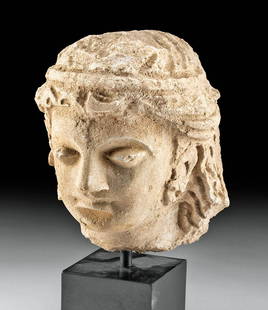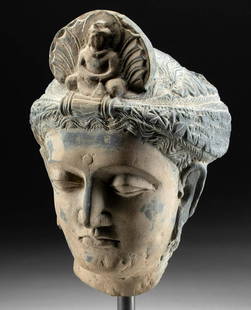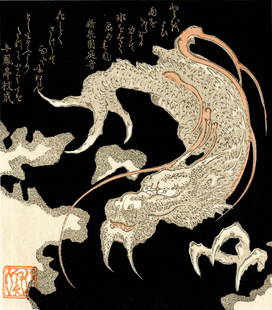
Published / Huge 4th C. Gandharan Stucco Buddha Head
Similar Sale History
Recommended Items







Item Details
Description
Central Asia, Pakistan and Afghanistan, Gandharan Empire, ca. 4th to mid-5th century CE. A larger-than-life stucco head of the enlightened Buddha, modeled in the traditional Greco-Buddhist manner with a full face, fine, heavy-lidded downcast almond eyes, a naturalistic nose, a sensitive mouth, a strong brow line, and a distinctive chin. The ears are long, their lobes stretched, signifying the former wealth of Prince Siddhartha. A deep, round urna is in the center of the forehead, which was likely once inlaid with a precious stone. Some traces of pigment remain on the face, notably on the brow line and on the cheeks. Perhaps the most incredible part of this sculpture is its ornate coiffure and huge ushnisha. The hair is composed of layer upon layer of half-circles of stucco, giving it the appearance of tight curls, and these continue over the ushnisha, the visible sign of Buddha's enlightenment. Size: 12.25" L x 12" W x 19" H (31.1 cm x 30.5 cm x 48.3 cm); 25" H (63.5 cm) on included custom stand.
Alexander the Great conquered Gandhara in 330 BCE and with the help of Indo-Greek kings introduced classical traditions that would influence Gandharan art for the following seven centuries. The stylized curly Mediterranean hair and top knot derive from classical sculptures such as the Apollo Belvedere (330 BCE), but the Gandharans took that influence and made a complete style of their own, often focused on portrayals of the Buddha, as is so beautifully exemplified here.
Gandharans are famous for schist and stucco carvings, with stucco replacing schist as the dominant material around the 3rd century CE. Vast monastic institutions like those at Takht-i-Bahi, Sahri-Bahlol, Jamal Garhi, Ranigat, and Thareli were decorated by skilled artisans with stucco representations of important figures, religious scenes, and artistic dedications. Stucco allowed artists more freedom in portraying lifelike features, as shown in the shape of the chin here. During this time, Gandhara was exceptionally wealthy, profiting from trade along the Silk Road; patrons had resources to spend on the arts, creating a flowering of stucco artwork. Some monumental statues had stucco hands, feet, and heads alongside clay torsos - the size of these figures was such that clay was needed to maintain their form.
Published in "The Muse's Song: Selections of Ancient Art." Fortuna Fine Arts, Ltd., New York, 2008, fig. 55.
This piece has been searched against the Art Loss Register database and has been cleared. The Art Loss Register maintains the world's largest database of stolen art, collectibles, and antiques.
Provenance: East Coast collection, New York Gallery, New York City, New York, USA, acquired before 2010; ex-Alexandre A du M collection, Maryland, USA, acquired in the 1980s
All items legal to buy/sell under U.S. Statute covering cultural patrimony Code 2600, CHAPTER 14, and are guaranteed to be as described or your money back.
A Certificate of Authenticity will accompany all winning bids.
PLEASE NOTE: Due to recent increases of shipments being seized by Australian & German customs (even for items with pre-UNESCO provenance), we will no longer ship most antiquities and ancient Chinese art to Australia & Germany. For categories of items that are acceptable to ship to Australia or Germany, please contact us directly or work with your local customs brokerage firm.
Display stands not described as included/custom in the item description are for photography purposes only and will not be included with the item upon shipping.
#142458
Alexander the Great conquered Gandhara in 330 BCE and with the help of Indo-Greek kings introduced classical traditions that would influence Gandharan art for the following seven centuries. The stylized curly Mediterranean hair and top knot derive from classical sculptures such as the Apollo Belvedere (330 BCE), but the Gandharans took that influence and made a complete style of their own, often focused on portrayals of the Buddha, as is so beautifully exemplified here.
Gandharans are famous for schist and stucco carvings, with stucco replacing schist as the dominant material around the 3rd century CE. Vast monastic institutions like those at Takht-i-Bahi, Sahri-Bahlol, Jamal Garhi, Ranigat, and Thareli were decorated by skilled artisans with stucco representations of important figures, religious scenes, and artistic dedications. Stucco allowed artists more freedom in portraying lifelike features, as shown in the shape of the chin here. During this time, Gandhara was exceptionally wealthy, profiting from trade along the Silk Road; patrons had resources to spend on the arts, creating a flowering of stucco artwork. Some monumental statues had stucco hands, feet, and heads alongside clay torsos - the size of these figures was such that clay was needed to maintain their form.
Published in "The Muse's Song: Selections of Ancient Art." Fortuna Fine Arts, Ltd., New York, 2008, fig. 55.
This piece has been searched against the Art Loss Register database and has been cleared. The Art Loss Register maintains the world's largest database of stolen art, collectibles, and antiques.
Provenance: East Coast collection, New York Gallery, New York City, New York, USA, acquired before 2010; ex-Alexandre A du M collection, Maryland, USA, acquired in the 1980s
All items legal to buy/sell under U.S. Statute covering cultural patrimony Code 2600, CHAPTER 14, and are guaranteed to be as described or your money back.
A Certificate of Authenticity will accompany all winning bids.
PLEASE NOTE: Due to recent increases of shipments being seized by Australian & German customs (even for items with pre-UNESCO provenance), we will no longer ship most antiquities and ancient Chinese art to Australia & Germany. For categories of items that are acceptable to ship to Australia or Germany, please contact us directly or work with your local customs brokerage firm.
Display stands not described as included/custom in the item description are for photography purposes only and will not be included with the item upon shipping.
#142458
Condition
Small losses on surface, notably on the side of the ushnisha and one earlobe. Back of the head is partially lost as is part of the neck, and these areas are fragile and may lose some material if not handled with care. Traces of pigment on face with nice deposits. Face and front of hair are beautifully preserved.
Buyer's Premium
- 26.5%
Published / Huge 4th C. Gandharan Stucco Buddha Head
Estimate $15,000 - $25,000
7 bidders are watching this item.
Shipping & Pickup Options
Item located in Louisville, CO, usOffers In-House Shipping
Local Pickup Available
Payment

Related Searches
TOP


















































